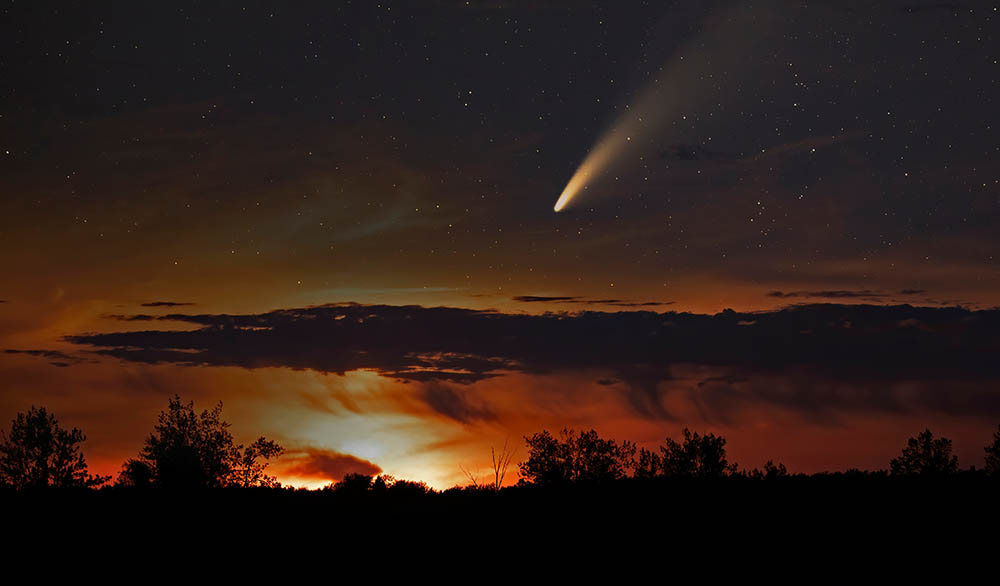How Fast Does a Comet Travel? What You Need to Know!
Last Updated on

Although scientists are not sure exactly how fast comets travel, it is estimated that comets travel between 2,000–100,000 miles per hour. Whenever the comet approaches the Sun, its speed will increase and often exceed 100,000 miles per hour due to Kepler’s Law1 .
Keep reading to learn more about how fast comets travel. What you learn in this article will definitely open your eyes to the reality of a comet.

How Fast Do Comets Travel?
As you might imagine, it is difficult for scientists to have an exact number for how fast comets travel. Even so, they have some accurate predictions. Scientists believe that most comets travel between 2,000–100,000 miles per hour during their orbit.

Changes in Speed
A comet’s speed changes based on its proximity to the Sun. Whenever a comet is far away from the Sun in its orbit, it travels at about 2,000 miles per hour. As though 2,000 miles per hour is not already fast, the comet’s speed increases as it approaches the Sun. It is predicted that comets may travel well over 100,000 miles per hour whenever it’s around the Sun.
The comet’s change in speed has to deal with the fact that the orbits are elliptical. This means that the comets change their distance from the Sun at all times. So, comets will gain speed whenever they are closer to the Sun and lose speed whenever they get further away from it.
The fact that comets get faster whenever they get closer to the Sun is explained in Kepler’s Law of Areas. The law of Areas finds that bodies will move faster whenever they’re closer to the Sun, allowing them to have a longer path at any given time.
How Fast Is the Neowise Comet Traveling?
Comet Neowise is a long-period comet. It has a nearly parabolic orbit, and it was only discovered on March 27th of 2020. It is estimated that its orbital period is around 4,400 years inbound, which is why it has only recently been discovered.
Even though it takes a long time for the comet Neowise to make it around its orbit, it is traveling very quickly. It is estimated that this comet is traveling at 40 miles per second, which is roughly 144,000 miles per hour. To put that in perspective, the comet’s speed is about twice as fast as Earth’s moving speed around the Sun.

How Do Comets Travel So Fast?
The speed of the comet is determined by its elliptical orbit. Comets have a highly elliptical orbit that goes around the Sun. What this means is that comets always come back to the Sun, even if they have spent hundreds and thousands of years out in the Solar System.
The fact that the comet has an elliptical orbit explains why comets travel so fast. The Sun’s gravity is what propels the comets to move faster whenever they are closer to the Sun but slow down whenever they are further away. So, the short answer to the question is the Sun’s gravity.
You can learn more about how comets travel fast and change their speeds by reading up on Kepler’s Laws of Planetary Motion.

Conclusion
Once again, comets travel at about 2,000–100,000 or more miles per hour. This speed range is due to the fact that the comet will slow down the further away it gets from the Sun. Conversely, the speed increases as it gets close to the Sun, thanks to the Sun’s gravity.
Even though comets are traveling at extreme speeds, it can still take hundreds and thousands of years for the comet to make its orbit. This explains why some comets, such as comet Neowise, have not been discovered until recently, despite their insanely fast speeds.
Featured Image Credit: Jim Cumming, Shutterstock
About the Author Robert Sparks
Robert’s obsession with all things optical started early in life, when his optician father would bring home prototypes for Robert to play with. Nowadays, Robert is dedicated to helping others find the right optics for their needs. His hobbies include astronomy, astrophysics, and model building. Originally from Newark, NJ, he resides in Santa Fe, New Mexico, where the nighttime skies are filled with glittering stars.
Related Articles:
Can You Use Binoculars to Look At Stars? How to Choose the Right Pair
How to Clean a Refractor Telescope: Step-by-Step Guide
How to Clean a Telescope Eyepiece: Step-by-Step Guide
How to Clean a Rifle Scope: 8 Expert Tips
Monocular vs Telescope: Differences Explained (With Pictures)
What Is a Monocular Used For? 8 Common Functions
How to Clean a Telescope Mirror: 8 Expert Tips
Brightfield vs Phase Contrast Microscopy: The Differences Explained
